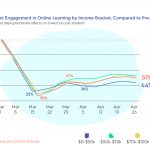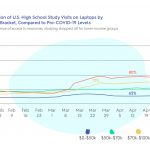
Articles
K-12
Pandemic Student Study Habits Began to Vary by Income Bracket, According to Quizlet Report
By Aniqah Majid
August 21, 2020
As lockdown restraints loosen, many students and teachers are beginning to orient their focus around the next academic year, where social distancing and remote learning measures will continue to take place. Many students worldwide will rely on technology and independent learning if they are to progress further in education. A report by the popular study platform Quizlet published this month suggests that student study habits can range drastically between income brackets. Low-income students have less access to laptop or desktop devices, study less, and have lower rates of perseverance, according to the report.
The State of Remote Learning Report 2020 compares platform learning behavior with U.S. Census Bureau data during March and April of this year. It details how, before the outbreak of covid-19, student study habits tended to be similar across income brackets. But once schools were closed and learning was brought online, behavior began to vary.
Pre-Covid-19 study habits were similar across income brackets. Then that began to change.
At first students began studying less. Participation rates across all brackets dropped to between 30% and 35% of pre-covid activity, bottoming out between March 15 and March 22. Then, things began to diverge. Students from families who earn between $50,000-$70,000 quickly regained ground and were back above 50%. These learners were trailed somewhat by students whose families earn more than $100,000. But students from families earning less than $50,000 remained at around a third of their pre-covid-19 study habits into April. By the end of the month, they still had not made the same progress that others made.

Student study habits also diverged when it came to device use. The rate of learners using laptop devices to study increased in each of the top three income brackets. For students in the top income bracket, laptop use shot up over 10% during the initial lockdown period. But for low-income students, laptop use remained flat at 65% throughout this period. Over one-third of these students were using either tablets or mobile devices to study.

A lack of access to vital technological equipment is keeping low-income students from transitioning into a post-covid education system.
Laptop Use Shot Up for Affluent Students
The report unearthed numerous other interesting takeaways. For example, while student study habits (using Quizlet) declined in the U.S. and France, they ballooned in other countries such as Italy, Singapore, and Poland. In South Korea and Brazil, Quizlet use increased by roughly 300%.
During this period, American students turned to subjects that engaged them. The subject analysis in the report found that, although students have been demotivated to carry on with foundational subjects like English and math, 58-61% of students occupied themselves with hobbies like sports, gardening, and cooking. Others sought practical skills in interview techniques and resume building.
AP exams were of the few examinations which were not cancelled due to COVID. Quizlet saw an increase in engagement in subjects like economics, 14% above average, and statistics and probability, 89% above average. This data shows that American students have become more selective about what they choose to study online, opting out of traditional studying methods and pursuing subjects and interests which may benefit them outside of academe.
Featured Image: Annie Spratt, Unsplash.









No Comments